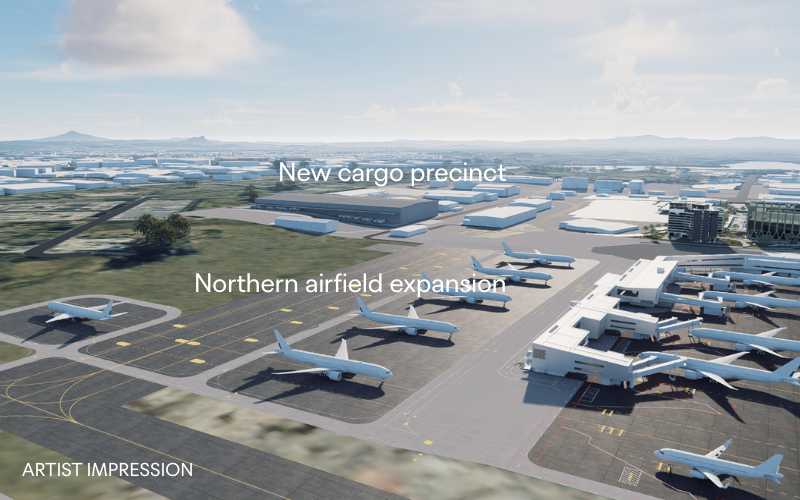
Fruit & veg takes flight from AKL & new cargo precinct on the horizon
- 2025-05-02
- Overall fruit and vegetable air freight was up 34% since last summer
- 175% (1,448 tonnes) growth in avocados air freighted from AKL across the 2024/25 summer months compared to previous summer
- Cherries and capsicums were high on the export list over summer (2,888 tonnes and 1,493 tonnes respectively)
- New cargo precinct development underway at AKL, bringing cargo operators together into one place, and reducing truck trips on core roading network.

Freighting fresh fruit and vegetables by air cargo was on the rise via Auckland Airport over the summer months, with a standout being the avocado.
Overall, fruit and vegetable air freight was up 34% since last summer, flying from AKL to destinations around the world (year on year from 1 December 2024 to 28 February 2025).
.jpg)
North Island avocado company Avanza – who exported over 550 tonnes via Auckland Airport globally over December 2024 to February 2025 – said impacts from the recent Cyclone Tam are not yet fully known but an increased crop in terms of fruit numbers will help for the year ahead, after just recently coming back after Cyclone Gabrielle.
AKL saw avocado air freight increase by a whopping 175% on the previous summer, given the fruit had been so heavily impacted by severe weather in early 2023, impacting crops all the way into summer of 2023/2024.
Between 1 December 2024 and 28 February 2025, more than 1,448 tonnes of avocados were exported from the airport in total, with the highest demand to destinations including Australia and markets in Asia including Thailand and Singapore.
Auckland Airport’s Chief Customer Officer Scott Tasker said: “New Zealand growers compete on the international stage, and they’ve made themselves successful through quality and premium products.
“Time is of the essence with fresh produce and great air connections into key global markets means produce arriving in the best shape possible to command premium prices.”
Avanza’s Steve Trickett said they are still assessing the impacts from the recent cyclone.
“We remain positive for the next season, but the Mid North appears to have been hit the worst. The Bay of Plenty, where around 60 per cent of volume comes from, were mostly unaffected depending on orchard location, but it’s likely there will be some affect to cosmetic grade with things like wind rub.
“For us, being able to reliably freight our great Kiwi produce around the world means a lot. It must travel a long way to get anywhere. After we do the work on our side in the orchard and in the packing houses, we then rely on our cargo operators to get it around the globe safely and efficiently, so we can feed the world with our nutritious New Zealand fruit,” said Mr Trickett.
Seasonal produce
Mr Tasker added: “We saw solid growth at AKL over summer with an increase in fresh produce, not just avocados but also cherries and blueberries, all being freighted in the belly hold of aircraft.”
There were 2,888 tonnes of cherries – the equivalent of filling up 30 x 747 freighters – air freighted to destinations including Greater China and Vietnam across the summer months, making it the top export item overall for summer in terms of tonnage. This was up by 53% year on year.
Capsicums were the second largest seasonal produce item with 1,493 tonnes, mainly to destinations including Japan and Australia, and the fourth largest export item overall for summer coming in after cherries, infant formula and food preparation items such as biscuits and jams.
Mr Tasker said blueberries were the fourth largest seasonal produce item freighted out of AKL (after avocados) with 935 tonnes, up 36 per cent on the previous year.
“With cherries from Cromwell to avocados from Katikati and citrus from the far North, connectivity is key to ensure local growers can tap markets in all corners of the globe,” said Mr Tasker.
Auckland Airport’s share of total New Zealand international air cargo has grown to 86%.
New cargo precinct
Preparations are underway for a new cargo precinct, located in Manu Tapu Drive, directly adjacent to the new 250,000m2 airfield expansion.
“Cargo is a core part of the airport eco-system but currently, cargo and freight operators are spread out across the precinct from when it was set up in the late 1960s,” said Mr Tasker.
“To make things more efficient, these operators will be progressively moving into a single cargo precinct. This new precinct will function more like a modern port."
With airfield access including a purpose-built road leading straight from the cargo precinct onto the expanded airfield area, due to open later this year, the new precinct future-proofs AKL’s cargo capacity.
The cargo precinct will also link in directly with the upgraded roading network, with improved access via the newly built Te Ara Kōrako, as well as improvements to Joseph Hammond Road, George Bolt Memorial Drive and Manu Tapu Drive. This will move truck trips off the main roads to the passenger terminals at Auckland Airport and instead send them directly to the cargo precinct.
“The $30.7 million investment in the airport’s transport network has been key to enabling improved access to what will be a new cargo precinct. This provides cargo and freight operators with improved access into the cargo precinct, taking some of the incoming and outgoing cargo off the airport’s core roading network and prioritising customer journeys to the terminals.
“Smooth cargo operations are an essential contribution to New Zealand’s economic output. A daily wide body passenger aircraft across a year can carry around $500 million in high-value freight, these contributed to over $2.6 billion in total of exported goods over the summer season.
“It’s crucial that we’re assisting regional New Zealand to efficiently get their goods out to the world and air cargo will remain an important part of our infrastructure upgrades as we're building the airport for the future,” said Mr Tasker.
In a recent EY report, Auckland Airport is projected to facilitate NZ$41.1 billion in annual freight movements by 2032, supported by its investment in aeronautical infrastructure, including an expanded airfield and new domestic jet terminal. Today, Auckland airport is New Zealand’s third largest port by cargo value handled, with $26.6 billion of exports and imports combined in 2024.
The summer aircraft connections at Auckland Airport generated over an estimated $3.2 billion in visitor spend in New Zealand in the last quarter of 2024.
Summer fruit and vegetable exports from 1 December 2024 – 28 February 2025:
• Cherries (2,888 tonnes) +53% year on year
• Capsicum (1,493 tonnes) – 6% year on year
• Avocados (1,448 tonnes) +175% year on year
• Blueberries (935 tonnes) +36% year on year
• Tomatoes (703 tonnes) +57% year on year
• Kiwiberries (187 tonnes)
• Apricots (100 tonnes)
• Strawberries (36 tonnes)
• Peaches (22 tonnes)
• Plums (17 tonnes) - up 671% year on year









